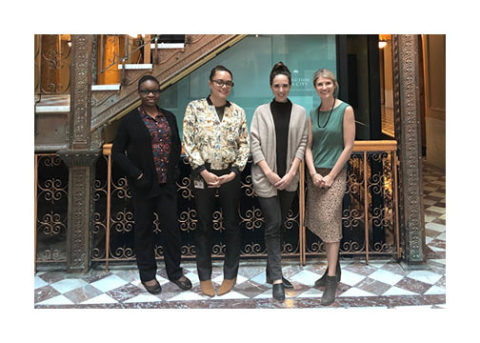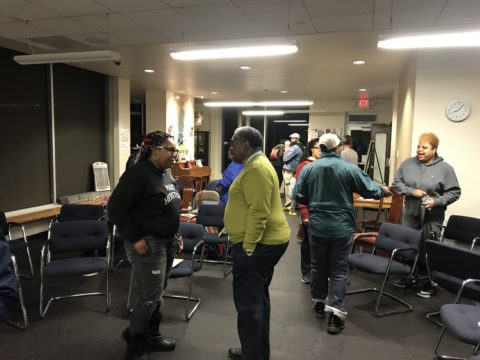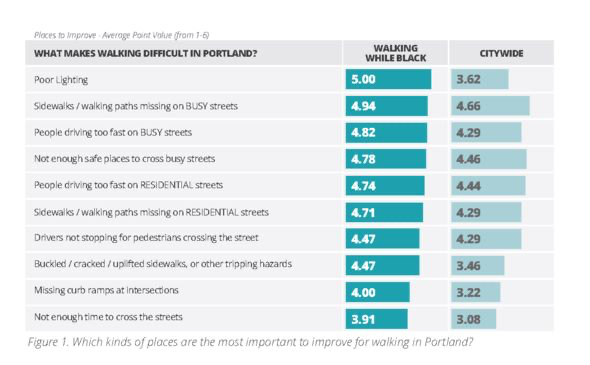2019 Weston Winner:
PedPDX Walking While Black Team
 PedPDX is Portland’s new Citywide Pedestrian Plan, adopted by City Council in June 2019. PedPDX prioritizes sidewalk and crossing improvements along with other initiatives to make walking safer and more comfortable across the city.
PedPDX is Portland’s new Citywide Pedestrian Plan, adopted by City Council in June 2019. PedPDX prioritizes sidewalk and crossing improvements along with other initiatives to make walking safer and more comfortable across the city.
In the early work developing the work plan for PedPDX, project staff struggled with how to acknowledge the very different experiences that Portlanders have navigating the city as pedestrians. Specifically, they were aware of a 2017 study led by Kimberly Kahn at Portland State University (“Racial bias in driver yielding behavior at crosswalks”) that found that drivers are less likely to stop for Black pedestrians waiting in a crosswalk than for White pedestrians. The study found that Black male pedestrians were passed by twice as many cars and waited 32% longer than White male pedestrians. They were also aware of data indicating that Black pedestrians in Portland are stopped by police at higher rates than pedestrians of other races.
The vision of PedPDX is to make Portland a great walking city for all. Accomplishing this required us to have a better understanding of the different set of challenges faced by non-white people walking on Portland streets.
A key element of the early PedPDX public involvement strategy included a broad, citywide survey asking Portlanders to tell PBOT their priorities for making Portland a more walkable city. Out of the 5,405 total survey respondents, 2% of total respondents identified as Black/ African American/African, however they represent 5.7% of Portland’s overall population.
In recognition of the low response rates from Black Portlanders in comparison to their counterparts and the need for a deeper understanding of the concerns, interests, and needs specific to the Black community, the PedPDX project team sought assistance for facilitating additional outreach efforts.
PBOT Equity + Inclusion staff volunteered to organize and facilitate two Walking While Black focus groups to better understand the walking priorities, transportation barriers, and experiences that are unique to Black Portlanders. Staff worked with community partners from the Portland African American Leadership Forum (PAALF), Black Parent Initiative (BPI) and Immigrant and Refugee Community Organization (IRCO) Africa House to host the two focus groups. Facilitators provided a space for Black Portlanders to speak candidly about their Walking While Black experience in Portland.

The feedback that the project team received from Walking While Black participants truly impacted the content of PedPDX and has directly influenced PBOT funding priorities. The feedback from Walking While Black directly informed six actions in the PedPDX toolbox intended to address public safety and security concerns for people walking on city sidewalks. One of the most striking messages that arose from participants (that did not arise from the citywide survey) was the need for more and better street lighting. Inadequate street lighting was cited as the number one barrier to walking by Walking While Black participants.

Focus group discussion about lighting led to a deeper understanding about concerns for personal safety in public spaces and during travel commutes. Participants shared the choices they make on a daily basis to travel on routes that make them feel safe and visible, even if the travel route is longer or the travel option is more expensive. This feedback helped PBOT staff better understand the importance of better street lighting not only to improve traffic safety, but also to provide a better sense of personal safety and security for people walking.
In response to what we heard, PBOT Signals and Street Lighting has updated the City’s street lighting level guidelines. These new guidelines were adopted with PedPDX and are already being implemented as part of capital projects. Additionally, PBOT is currently developing a funding strategy to improve lighting conditions and pedestrian visibility with a focus on High Crash Corridors and intersections within historically underserved areas. This includes a dedicated funds within the Fixing Our Streets bond renewal proposal specifically earmarked for street lighting improvements.
“When there are no lights, I feel unsafe. I don’t have the choice, I have to take the MAX, I have to walk.”
Walking While Black focus group participant“Lighting is very important if we really want to protect Black lives, not everyone has shiny clothes on them. Proper lighting especially helps people with dark skin. If we had enough light everywhere, it would be safer citywide to walk while Black. White drivers don’t see Black people, even in [the] daytime. “
Walking While Black Focus Group participant
Join us in celebrating
PedPDX Walking While Black Team at the Weston Awards on Friday, November 8th
Thank you to our platinum co-sponsors!




Thank you very much for sharing, I learned a lot from your article. Very cool. Thanks. nimabi